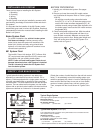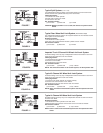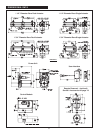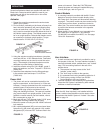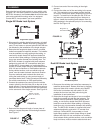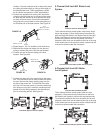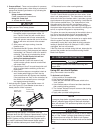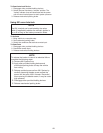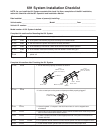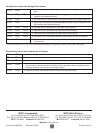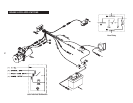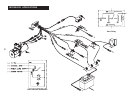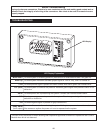
11
6. Pressure Bleed - There are two options for pressure
bleeding the brake system, either using a commercial
pressurized bladder type bleeder or by activating the
691 Power Unit.
Using commercial bleeder
Follow manufacturer's instructions.
Using 691 Power Unit
A. Activate the 691 System.
B. Starting at the actuators and moving outward to
foundation brakes, open bleeder screw 1/2
turn. The 691 Power Unit will run with the re-
lease of pressure and will stop automatically
when the actuator reaches the end of its stroke.
Most air will come out at end of the actuator
stroke.
C. After power unit stops running, close the
bleeder screw.
D. Deactivate the 691 System. After 691 Power
Unit stops running, slowly depress and release
brake pedal 3 to 5 times or until a firm pedal is
achieved. This step is to replenish the actua-
tors. NOTE: The 691 Power Unit will run
during first brake application.
E. Be sure the 691 Power Unit reservoir and
vehicle master cylinder reservoir remain filled
with proper fluid.
F. Repeat steps A thru E at each bleed point until
all air is purged before switching to the next
bleed point.
G. After the above steps are completed, check to
see if brake pedal height and "feel" are the
same as before the 691 System was installed.
If the pedal does not "feel" as firm as before, let
the vehicle sit for several hours or overnight
and repeat pressure bleeding.
7. Activate the 691 System. Open bleeder screw 1/4
turn. See Figure 23. Close bleeder screw when a
steady stream of fluid is present.
8. Reconnect horn or other warning devices.
The 691 Control Module provides two alarm wires: "direct
alarm" and "delayed alarm". The "direct alarm" wire is the
white wire in the User Interface cable. It provides a ground
signal whenever the system is pressurizing. It activates the
User Interface audible alarm. The "delayed alarm" wire,
the yellow wire in the main 691 wire harness, is also
referred to as the horn wire. It provides a ground signal if
the system takes longer than nine seconds to initially pres
-
surize, or anytime the system is re-pressurizing.
The yellow wire must be connected to the vehicle's horn or
to a form of warning device that will guarantee that the
operator is aware that the system is re-pressurizing.
The horn warning circuit must be tested on a regular basis.
After the system has been activated and is locked,
momentarily unplug the 2-wire (black & white) connector
leading to pressure switch #2 (stamped "1-800"). While
unplugged, the horn will activate.
If the horn does not activate during this test, determine the
cause of the problem and correct before using the 691
Brake Lock System.
Using 691 as a Lock System
(Only units with 691 User Interface)
To Activate Lock System
1. Bring vehicle to a complete stop.
2. Set mechanical parking brake.
3. Move the user interface lock/release switch to the
"lock" position.
4. User Interface alarm will sound and then deactivate
after reaching locking pressure.
5. The "locked" indicator lamp will come on after locking
pressure is reached.
6. Apply other provided holding devices.
Be careful when opening the bleeder screw, it will be un
-
der high pressure. Wear safety glasses.
Power Unit
Bleed Point
Power Un
i
t
Bleed Point
FIGURE 23
Before moving the vehicle, a firm pedal must be
achieved when the 691 System is deactivated. If a firm
pedal is not achieved, repeat bleeding procedure for
the 691 System and the service brake system until a
firm pedal is achieved. Make several brake applica
-
tions with vehicle stationary and check fittings for
leaks.
HORN WARNING CIRCUIT TEST
Do not operate power unit without first filling with
proper fluid.
691 OPERATING INSTRUCTIONS
NOTE
If pressure drops below required system pressure, the
"locked" indicator lamp will go off and user interface
alarm will activate. This process may take only a frac
-
tion of a second.
If user interface alarm does not sound or fails to deacti
-
vate or if the "locked" indicator lamp does not remain
on, discontinue use of the 691 Brake Lock System.
Determine the cause of the problem and correct before
using.



